
The djembe (pronounced 'jem-beh') is the goblet-shaped hand drum from West Africa.
Djembe history is a rich and diverse subject, but it can be difficult to verify. Africans have long passed down their history by word of mouth and accounts may change over time and across regions. We have done our best to gather together all the available facts.
Where does the djembe drum come from?
We don't know the drum's exact origins, but historians agree that it was invented by the Mandinka (or Maninke) people of western Africa in around 1300 AD.
At the time King Sundiata ruled over the Mandinka people and the people widely celebrated him as a hero. He conquered a huge empire stretching over modern day Guinea, Mali, Burkina Faso, Côte d'Ivoire, Gambia, and Senegal.
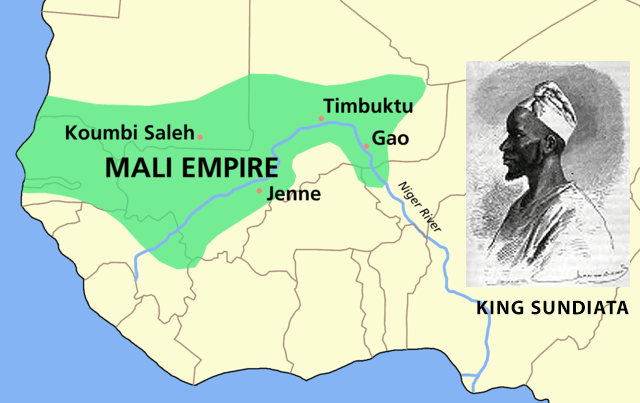
Mandinka people divided their society into castes or groups of professions. The Numu were a blacksmith caste. They were the first to be associated with the djembe, and played it only during the smelting of iron ore.
Historians believe that as blacksmiths migrated, the drum and its culture spread through west Africa.

Over time, the popularity of the djembe grew beyond the Numu caste. Players became known as djembefola ('one who plays the djembe'). Some formed groups and would travel between various events and performances.
Today the djembe is a large part of daily life in Mali, Guinea, the Gambia, Senegal, Cote d'Ivoire and Burkina Faso.
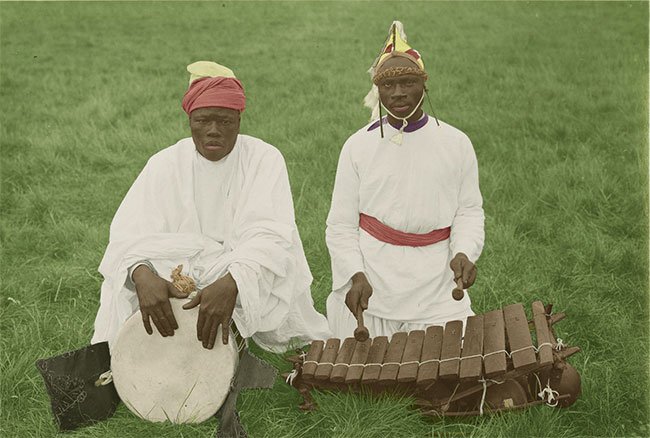
Djembe History in Myths and Legends
There are many colorful legends of djembe history and how the drum may have originated.
One goes that the basic shell evolved out of the large mortar used for pounding grain or millet.
Apparently, the village fool's wife pounded a hole clear through the bottom of it one day while he was conveniently hanging around with a goat skin. He stretched it over the head of the mortar and the rest is djembe history.
Here's another one, and my favourite, edited from recounts by Hugo Zemp in [amazon_textlink asin='B000BWIZTK' text='the book African Percussion by Serge Blanc' template='ProductLink' store='afrodrumming-20' marketplace='US' link_id='4609bb61-c27e-11e7-bc1e-2528262939b6'].

'Long ago, before humans knew of the drum, it was owned by the chimpanzees, who played it in the trees.
At that time there was a great trapper named So Dyeu. The chimpanzees would often come near his camp. One day So Dyeu spotted them eating fruit and entertaining themselves with the drum.
He said, 'This thing they are beating is beautiful, I will set a trap', so he dug a whole and laid a snare.
The next day he heard a great commotion and the sounds of the young and old chimpanzees crying. He went to investigate and found the chimpanzee drummer caught in the trap. So Dyeu captured the drum and returned to the village, where he gave it to the village chief.
The chief said, 'We have heard the voice of this thing for a long time, but no one has seen it until now. You have brought it to us; you have done well.' , and in return, the chief gave his first daughter to be So Dyeu's first wife.
So the chimpanzees no longer have the drum and that's why they can only beat their chests.
What is the djembe drum used for?
Musicians use the djembe as the instrument of dance at marriages, baptisms, funerals, circumcisions and excisions. They also play songs during the ploughing, sowing and harvest, during courtship rituals and even to settle disputes among the men of the village.
In west African society, certain instruments such as the balafon, the kora and the ngoni are subject to hereditary restrictions. This means that only members of the griot caste (historian/storyteller) may play them. The djembe is not a griot instrument and there are no restrictions on who may become a djembefola.
In daily life, various events are accompanied by unique songs and dances. The griot usually performs these, accompanied by drummers, singers and dancers. Songs tell of great leaders, like King Sundiata, or praise certain professions, like the cobblers or hunters.
In a typical ensemble, the griot is accompanied by two djembes and a dunun player.

A Traditional Djembe Ensemble
A typical djembe ensemble contains one soloist, one or two accompanying djembe and one to three dundun players. It is almost always accompanied by dancers and clapping.
The bass drums, or dundun, are usually played with sticks and provide the core structure of the rhythm. There are 3 types of bass drum that range in size and pitch. They are the doundounba (or dundun), the sangban and the kenkeni.

The djembe accompanists each play different rhythms alongside the bass drum to complete the basic song. The soloist introduces the song, accents the beats, controls the tempo and plays solo pieces over the rhythm provided.
Women sing and clap hands, while moving in and out of the circle and showing off their skill as dancers. The djembe master or soloist leads the pace of the dance. He or she increases the tempo when good dancers enter the circle. Traditionally, musicians play a single song for most occasions, usually lasting a few hours.
The Sekeseke
Traditionally, two or three metal plates, called sekeseke (or segesege in Mali, or kesekese in Guinea) are attached to the edge of the djembe.
The edges of these plates have been pierced and threaded with many wire rings.
They resonate in sympathy when the drum is played and accent the notes of the drum or kora (harp) with a jingling sound that adds to the 'voice of the drum'.

Similar resonators are used on other African instruments such as the mbira and the balafon.
Recent Djembe History
In the 1950s the world tours of Les Ballet Africains led by Fodeba Keita increased the djembe's popularity outside of Africa.
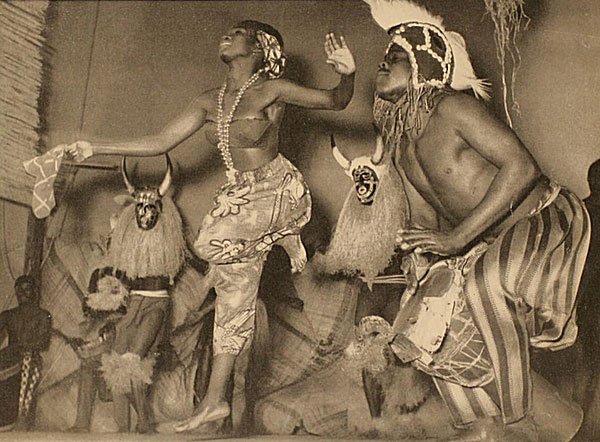
Les Ballets Africains
Around that time, Nigerian percussionist Babatunde Olatunji released Drums of Passion, an album of African drumming songs. Critics have widely acknowledged Drums of Passion to be the first African drumming album. Even though it did not feature the djembe, it did much to establish the genre.
As the global thirst for drumming grew, djembe ensembles performed for more Western audiences. Musicians soon found they could make a decent living away from home performing and teaching.
While players moved to Europe and America, ethnomusicologists moved to Africa to study the drum in it's natural environment. Researchers like Eric Charry, Marianne Friedländer and Serge Blanc have done much to document djembe history, the traditions and rhythms.
Artists such as Youssou N'Dour, Salif Keita and Baba Maal have used djembe in African pop music. Djembe players have toured the world with much success.

Salif Keita and djembe player
Today, the djembe appears in many music genres and even features in rock bands such Ben Harper and Jason Mraz.
The djembe has not lost its spirit of togetherness in translation either. Drum circles are a regular pastime for enthusiasts from all over the world. Drummers know the djembe to be an instrument of community and these events are just another way to get people together.
So join in and celebrate djembe history - the drum of a thousand voices has arrived.

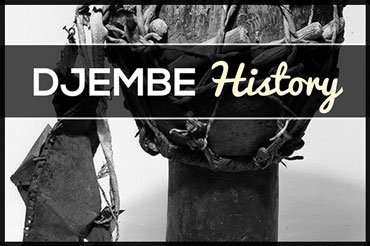


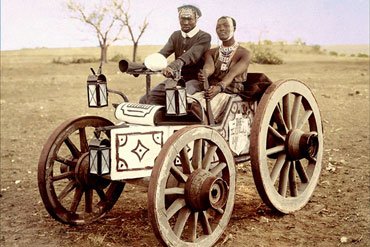
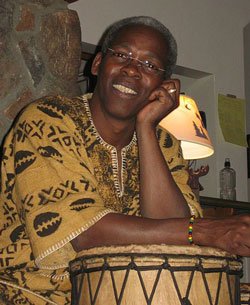

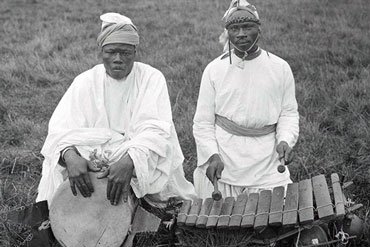








amazing website it is so helpful
WOW!!!!!
That is so interesting I did not know that chimpanzies used to play it on the trees !!!!!!!
i agree don’t you guys
this is such an amazing website that is so helpful for people learning how to play the djembe drum
i know it is
I am truly appreciative of this information. I am studying this in my Music In Cultural Expression class, so interesting!!
Wow…the heritage.